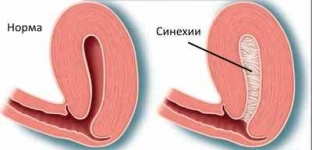Missing a period is rarely a good thing unless it's related to an expected pregnancy. In other cases, amenorrhea causes anxiety in the patient, which leads her to see a gynecologist.
Amenorrhea can be primary (absence of menstruation and signs of puberty before the age of 16) and secondary (abrupt cessation of menstruation after regular menstruation). Amenorrhea can be due to several reasons. As a rule, amenorrhea is regarded as a hormonal failure, and on this basis, women take hormonal drugs. But there is a condition that is rarely mentioned in the diagnosis of secondary amenorrhea.
Amenorrhoea often develops after what procedures?
If amenorrhea has developed in a woman who has undergone diagnostic curettage of the uterine cavity or who has had an abortion, this should not be overlooked when looking for the causes of amenorrhea. Often in such cases, amenorrhea is looking for endocrine disorders that could provoke the absence of menstruation. But it is important to know that there is not a single neuroendocrinological syndrome that could cause amenorrhea after diagnostic curettage or abortion.
Menstruation may stop after uterine surgery. The reason for this is the formation of adhesions after frequent or after rough curettage during abortion or diagnostic procedures. This process is called Asherman's syndrome, which characterizes the presence of intrauterine synechia after surgical procedures in the uterus.
Clinical picture and diagnosis of intrauterine synechia
A woman with Asherman's syndrome does not feel any pain. The only symptom is the absence of menstruation.

When examining such patients after collecting an anamnesis, it is advisable to perform transvaginal echography, which will make it possible to suspect the presence of intrauterine synechia. The most important diagnostic value in the detection of intrauterine synechia is a negative test with gestagens and estrogens. Hysteroscopy and hysterosalpingography makes it possible to see the typical signs of intrauterine synechia and clarify the diagnosis of Ascherman's syndrome or intrauterine synechia.
Tactics of treatment of intrauterine synechia in amenorrhea
The treatment of such a pathological condition as synechia inside the uterus consists only in surgical intervention - dissection of adhesions during hysteroresectoscopy.
After surgery, a course of hormonal preparations of natural sex hormones is prescribed. Combined oral contraceptives should not be used because of their ability to interfere with the process of endometrial proliferation, and they also contribute to the development of atrophic processes in the endometrium.
If a woman has a high temperature, leukocytosis in the blood and symptoms of intoxication, it is possible that these are synechiae in Asherman's syndrome of inflammatory etiology. With such a suspicion, curettage is performed, followed by microbiological and bacteriological examination. Also, after surgery, antibiotic therapy is carried out.
Thus, when a woman complains of amenorrhea, it is important to clarify her history of such surgical interventions as diagnostic curettage and abortion. In the presence of such manipulations on the uterus, a specialist in a diagnostic search should not exclude the presence of intrauterine synechia. This will positively affect the process of establishing an accurate diagnosis, as well as the timely appointment of treatment. After all, amenorrhea after manipulations on the uterus does not depend on hormonal disorders.






Add a comment